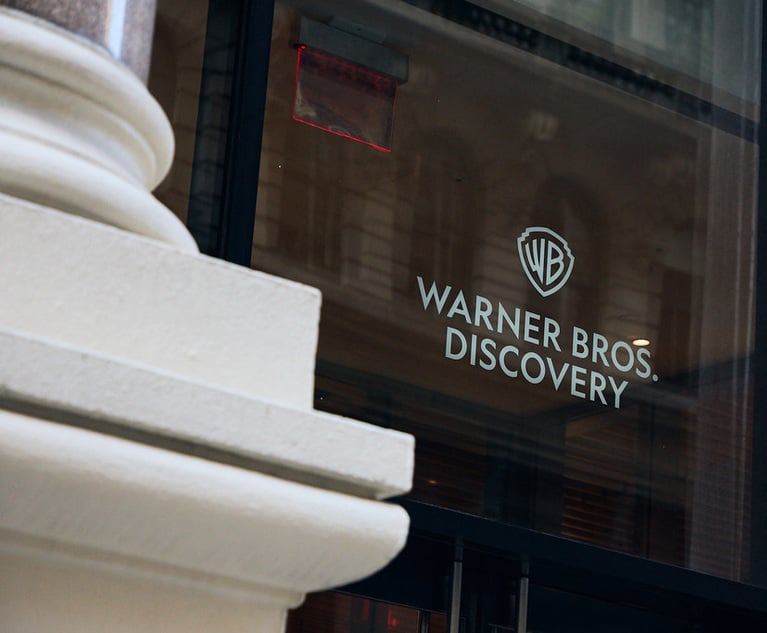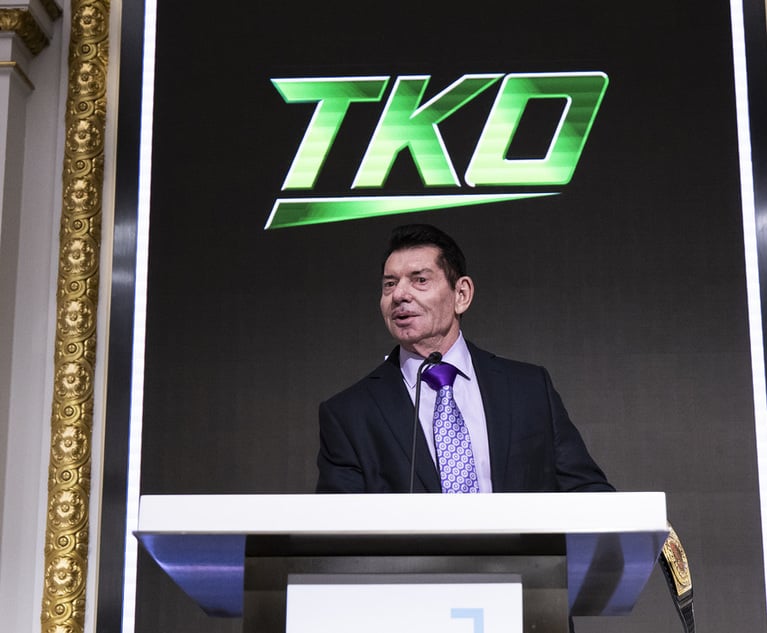IP: Territoriality and Well-Known Trademarks
A trademark must be used in U.S. commerce in order to be enforced in the United States.
May 16, 2011 at 08:00 PM
12 minute read
The original version of this story was published on Law.com
Trademark rights are territorial and ownership of a mark in one country generally provides no advantage when enforcing the mark in another country. This is particularly true in the United States where enforceable trademark rights arise from actual use of a mark in U.S. commerce, under what is referred to as the Territoriality Rule. If a foreign company has yet to use its mark in U.S. commerce, the Territoriality Rule can have the surprising and inequitable effect of precluding it from enforcing its mark against copycats in the U.S., even when the foreign company's mark is well-known abroad and in the U.S. While the Territoriality Rule is rooted in the commonsense idea that if a mark is not used in U.S. commerce, then U.S. consumers will not encounter it, globalization has rendered the rule anachronistic. Indeed, economic integration, increased travel and the Internet have changed the playing field. It is now very possible that U.S. consumers will recognize well-known brands used exclusively overseas and erroneously assume that a copycat in the U.S. is associated with the overseas brand owner. Accordingly, and contrary to the Territoriality Rule, proof of actual use in U.S. commerce should be unnecessary to underpin an infringement action involving a well-known mark. It is the reputation of a demonstrably well-known mark that should be protected and that reputation should be considered sufficient to create enforceable rights in a well-known foreign mark. Otherwise, foreign companies' successful marks are at risk of infringement in the U.S. by parties who could copy, use and seek to register the marks, preempting the foreign company in the U.S. market and leaving the foreign owner without reliable recourse.
By way of example, consider the case of a hypothetical well-known mark for a luxury pastry maker dating back to the late 1800s, originating and based in Paris, long used in connection with what have been widely recognized as the best macaroons in the world with more than 15,000 macaroons sold each day. The pastry maker and its signature stores began in Paris and then expanded, under the well-known mark, to several other countries, but it is not used in U.S. commerce. Nevertheless, Americans have had extensive exposure to the mark over the years, through among other things travel, gifts, magazines, newspapers and Internet publications, general word-of mouth and publicity and popular U.S. movies and television shows featuring luxury lifestyles, such as “Gossip Girl.” Even in these circumstances, due to the U.S. requirement that a mark must be used in U.S. commerce to be enforceable, a third party could conceivably adopt the well-known mark in connection with pastries in the U.S., leaving the owner without reliable recourse for the infringement of its well-known mark in the U.S.
The “well-known mark” doctrine may, in rare circumstances and in very limited jurisdictions, however, provide owners of well-known foreign marks protection from infringement in the U.S., despite the Territoriality Rule. Under this doctrine, marks that are used and well-known abroad may be enforced in a given country, even when they are not used in that country. The 9th Circuit expressly applied the well-known marks doctrine as an exception to the Territoriality Rule in Grupo Gigante S.A. de C.V. v. Dallo & Co. Importantly, the 9th Circuit's holding rested on public policy justifications and the court did not identify any federal statutory basis for this exception. Indeed, the general rule is that there is no basis for the well-known mark doctrine in federal law and a foreign trademark owner must use its mark in U.S. commerce if it expects to enforce its rights in the U.S. For example, in ITC Ltd., v. Punchgini, Inc., the 2nd Circuit expressly rejected the well-known mark doctrine in holding that well-known status in the U.S., based solely on use of the mark outside the U.S., cannot support an infringement action in the U.S. The United States Patent and Trademark Office's Trademark Trial and Appeal Board (TTAB) previously indicated support for the well-known mark doctrine in decisions involving the WIMBELDON trademark and others. However, more recently, the TTAB recognized that the well-known mark doctrine provides no independent cause of federal action and is not a basis for trademark opposition or cancellation proceedings in the TTAB.
Clearly, the Territoriality Rule needs a counterbalance as the world's economies become increasingly integrated through globalization. The U.S. is a member to the Paris Convention and the TRIPs Agreement and these international treaties could provide a counterbalance since Article 6bis of the Paris Convention and Article 16(2) of the TRIPs Agreement adopt the well-known marks doctrine. But U.S. courts have held that these treaties are not self-executing, so they cannot create substantive rights without implementing legislation from Congress. Unless Congress specifically implements these particular articles, foreign companies with well-known marks that are not in use in U.S. commerce cannot rely on these treaties to support an infringement action under a well-known mark theory.
Theoretically, a trademark dilution claim might be another option for a foreign trademark owner with no use in U.S. commerce. As a practical matter, however, a company could not meet the exacting proofs and extraordinary evidence of fame required to support a dilution claim if the subject mark was not used in U.S. commerce.
Against this background, how should a foreign company protect itself from possible copycats that may seek to preempt it in the U.S. market? If the foreign company has a bona fide intent to use the mark in U.S. commerce, it should file a trademark application for registration of the mark on an “intent-to-use” basis. Regardless of whether a foreign company can meet the enhanced filing standards for an “intent-to-use” trademark application, the company should gather and maintain evidence that its mark is well-known in the U.S. For example, consumer recognition surveys, exposure in movies, television, magazines, Internet publications, blogs, sales in the stores of international airports and other outlets frequented by international tourists, proof of recognition among ex-patriots and emigrants living in the United States and franchise/license inquires from U.S. companies could all help demonstrate well-known status. Essentially anything that may indicate U.S. consumers are aware of the mark is good evidence. In addition, a company should gather evidence showing the mark is highly recognized in international markets, including the duration and extent of use and promotion throughout the world, sales numbers, worldwide trademark registrations and decisions by foreign trademark tribunals affording the mark well-known status. If a copycat has already struck, then, in addition to the materials above, the foreign company should gather all the evidence it can indicating that the infringer intentionally copied the mark, highlighting the theft of its reputation and the infringer's unfair free-ride on the foreign company's efforts abroad.
Read Christopher Dolan's previous column.
Trademark rights are territorial and ownership of a mark in one country generally provides no advantage when enforcing the mark in another country. This is particularly true in the United States where enforceable trademark rights arise from actual use of a mark in U.S. commerce, under what is referred to as the Territoriality Rule. If a foreign company has yet to use its mark in U.S. commerce, the Territoriality Rule can have the surprising and inequitable effect of precluding it from enforcing its mark against copycats in the U.S., even when the foreign company's mark is well-known abroad and in the U.S. While the Territoriality Rule is rooted in the commonsense idea that if a mark is not used in U.S. commerce, then U.S. consumers will not encounter it, globalization has rendered the rule anachronistic. Indeed, economic integration, increased travel and the Internet have changed the playing field. It is now very possible that U.S. consumers will recognize well-known brands used exclusively overseas and erroneously assume that a copycat in the U.S. is associated with the overseas brand owner. Accordingly, and contrary to the Territoriality Rule, proof of actual use in U.S. commerce should be unnecessary to underpin an infringement action involving a well-known mark. It is the reputation of a demonstrably well-known mark that should be protected and that reputation should be considered sufficient to create enforceable rights in a well-known foreign mark. Otherwise, foreign companies' successful marks are at risk of infringement in the U.S. by parties who could copy, use and seek to register the marks, preempting the foreign company in the U.S. market and leaving the foreign owner without reliable recourse.
By way of example, consider the case of a hypothetical well-known mark for a luxury pastry maker dating back to the late 1800s, originating and based in Paris, long used in connection with what have been widely recognized as the best macaroons in the world with more than 15,000 macaroons sold each day. The pastry maker and its signature stores began in Paris and then expanded, under the well-known mark, to several other countries, but it is not used in U.S. commerce. Nevertheless, Americans have had extensive exposure to the mark over the years, through among other things travel, gifts, magazines, newspapers and Internet publications, general word-of mouth and publicity and popular U.S. movies and television shows featuring luxury lifestyles, such as “Gossip Girl.” Even in these circumstances, due to the U.S. requirement that a mark must be used in U.S. commerce to be enforceable, a third party could conceivably adopt the well-known mark in connection with pastries in the U.S., leaving the owner without reliable recourse for the infringement of its well-known mark in the U.S.
The “well-known mark” doctrine may, in rare circumstances and in very limited jurisdictions, however, provide owners of well-known foreign marks protection from infringement in the U.S., despite the Territoriality Rule. Under this doctrine, marks that are used and well-known abroad may be enforced in a given country, even when they are not used in that country. The 9th Circuit expressly applied the well-known marks doctrine as an exception to the Territoriality Rule in Grupo Gigante S.A. de C.V. v. Dallo & Co. Importantly, the 9th Circuit's holding rested on public policy justifications and the court did not identify any federal statutory basis for this exception. Indeed, the general rule is that there is no basis for the well-known mark doctrine in federal law and a foreign trademark owner must use its mark in U.S. commerce if it expects to enforce its rights in the U.S. For example, in ITC Ltd., v. Punchgini, Inc., the 2nd Circuit expressly rejected the well-known mark doctrine in holding that well-known status in the U.S., based solely on use of the mark outside the U.S., cannot support an infringement action in the U.S. The United States Patent and Trademark Office's Trademark Trial and Appeal Board (TTAB) previously indicated support for the well-known mark doctrine in decisions involving the WIMBELDON trademark and others. However, more recently, the TTAB recognized that the well-known mark doctrine provides no independent cause of federal action and is not a basis for trademark opposition or cancellation proceedings in the TTAB.
Clearly, the Territoriality Rule needs a counterbalance as the world's economies become increasingly integrated through globalization. The U.S. is a member to the Paris Convention and the TRIPs Agreement and these international treaties could provide a counterbalance since Article 6bis of the Paris Convention and Article 16(2) of the TRIPs Agreement adopt the well-known marks doctrine. But U.S. courts have held that these treaties are not self-executing, so they cannot create substantive rights without implementing legislation from Congress. Unless Congress specifically implements these particular articles, foreign companies with well-known marks that are not in use in U.S. commerce cannot rely on these treaties to support an infringement action under a well-known mark theory.
Theoretically, a trademark dilution claim might be another option for a foreign trademark owner with no use in U.S. commerce. As a practical matter, however, a company could not meet the exacting proofs and extraordinary evidence of fame required to support a dilution claim if the subject mark was not used in U.S. commerce.
Against this background, how should a foreign company protect itself from possible copycats that may seek to preempt it in the U.S. market? If the foreign company has a bona fide intent to use the mark in U.S. commerce, it should file a trademark application for registration of the mark on an “intent-to-use” basis. Regardless of whether a foreign company can meet the enhanced filing standards for an “intent-to-use” trademark application, the company should gather and maintain evidence that its mark is well-known in the U.S. For example, consumer recognition surveys, exposure in movies, television, magazines, Internet publications, blogs, sales in the stores of international airports and other outlets frequented by international tourists, proof of recognition among ex-patriots and emigrants living in the United States and franchise/license inquires from U.S. companies could all help demonstrate well-known status. Essentially anything that may indicate U.S. consumers are aware of the mark is good evidence. In addition, a company should gather evidence showing the mark is highly recognized in international markets, including the duration and extent of use and promotion throughout the world, sales numbers, worldwide trademark registrations and decisions by foreign trademark tribunals affording the mark well-known status. If a copycat has already struck, then, in addition to the materials above, the foreign company should gather all the evidence it can indicating that the infringer intentionally copied the mark, highlighting the theft of its reputation and the infringer's unfair free-ride on the foreign company's efforts abroad.
Read Christopher Dolan's previous column.
This content has been archived. It is available through our partners, LexisNexis® and Bloomberg Law.
To view this content, please continue to their sites.
Not a Lexis Subscriber?
Subscribe Now
Not a Bloomberg Law Subscriber?
Subscribe Now
NOT FOR REPRINT
© 2025 ALM Global, LLC, All Rights Reserved. Request academic re-use from www.copyright.com. All other uses, submit a request to [email protected]. For more information visit Asset & Logo Licensing.
You Might Like
View All


SEC Puts Beat Down on Ex-Wrestling CEO Vince McMahon for Not Reporting Settlements
3 minute readTrending Stories
- 1'It's Not Going to Be Pretty': PayPal, Capital One Face Novel Class Actions Over 'Poaching' Commissions Owed Influencers
- 211th Circuit Rejects Trump's Emergency Request as DOJ Prepares to Release Special Counsel's Final Report
- 3Supreme Court Takes Up Challenge to ACA Task Force
- 4'Tragedy of Unspeakable Proportions:' Could Edison, DWP, Face Lawsuits Over LA Wildfires?
- 5Meta Pulls Plug on DEI Programs
Who Got The Work
Michael G. Bongiorno, Andrew Scott Dulberg and Elizabeth E. Driscoll from Wilmer Cutler Pickering Hale and Dorr have stepped in to represent Symbotic Inc., an A.I.-enabled technology platform that focuses on increasing supply chain efficiency, and other defendants in a pending shareholder derivative lawsuit. The case, filed Oct. 2 in Massachusetts District Court by the Brown Law Firm on behalf of Stephen Austen, accuses certain officers and directors of misleading investors in regard to Symbotic's potential for margin growth by failing to disclose that the company was not equipped to timely deploy its systems or manage expenses through project delays. The case, assigned to U.S. District Judge Nathaniel M. Gorton, is 1:24-cv-12522, Austen v. Cohen et al.
Who Got The Work
Edmund Polubinski and Marie Killmond of Davis Polk & Wardwell have entered appearances for data platform software development company MongoDB and other defendants in a pending shareholder derivative lawsuit. The action, filed Oct. 7 in New York Southern District Court by the Brown Law Firm, accuses the company's directors and/or officers of falsely expressing confidence in the company’s restructuring of its sales incentive plan and downplaying the severity of decreases in its upfront commitments. The case is 1:24-cv-07594, Roy v. Ittycheria et al.
Who Got The Work
Amy O. Bruchs and Kurt F. Ellison of Michael Best & Friedrich have entered appearances for Epic Systems Corp. in a pending employment discrimination lawsuit. The suit was filed Sept. 7 in Wisconsin Western District Court by Levine Eisberner LLC and Siri & Glimstad on behalf of a project manager who claims that he was wrongfully terminated after applying for a religious exemption to the defendant's COVID-19 vaccine mandate. The case, assigned to U.S. Magistrate Judge Anita Marie Boor, is 3:24-cv-00630, Secker, Nathan v. Epic Systems Corporation.
Who Got The Work
David X. Sullivan, Thomas J. Finn and Gregory A. Hall from McCarter & English have entered appearances for Sunrun Installation Services in a pending civil rights lawsuit. The complaint was filed Sept. 4 in Connecticut District Court by attorney Robert M. Berke on behalf of former employee George Edward Steins, who was arrested and charged with employing an unregistered home improvement salesperson. The complaint alleges that had Sunrun informed the Connecticut Department of Consumer Protection that the plaintiff's employment had ended in 2017 and that he no longer held Sunrun's home improvement contractor license, he would not have been hit with charges, which were dismissed in May 2024. The case, assigned to U.S. District Judge Jeffrey A. Meyer, is 3:24-cv-01423, Steins v. Sunrun, Inc. et al.
Who Got The Work
Greenberg Traurig shareholder Joshua L. Raskin has entered an appearance for boohoo.com UK Ltd. in a pending patent infringement lawsuit. The suit, filed Sept. 3 in Texas Eastern District Court by Rozier Hardt McDonough on behalf of Alto Dynamics, asserts five patents related to an online shopping platform. The case, assigned to U.S. District Judge Rodney Gilstrap, is 2:24-cv-00719, Alto Dynamics, LLC v. boohoo.com UK Limited.
Featured Firms
Law Offices of Gary Martin Hays & Associates, P.C.
(470) 294-1674
Law Offices of Mark E. Salomone
(857) 444-6468
Smith & Hassler
(713) 739-1250







